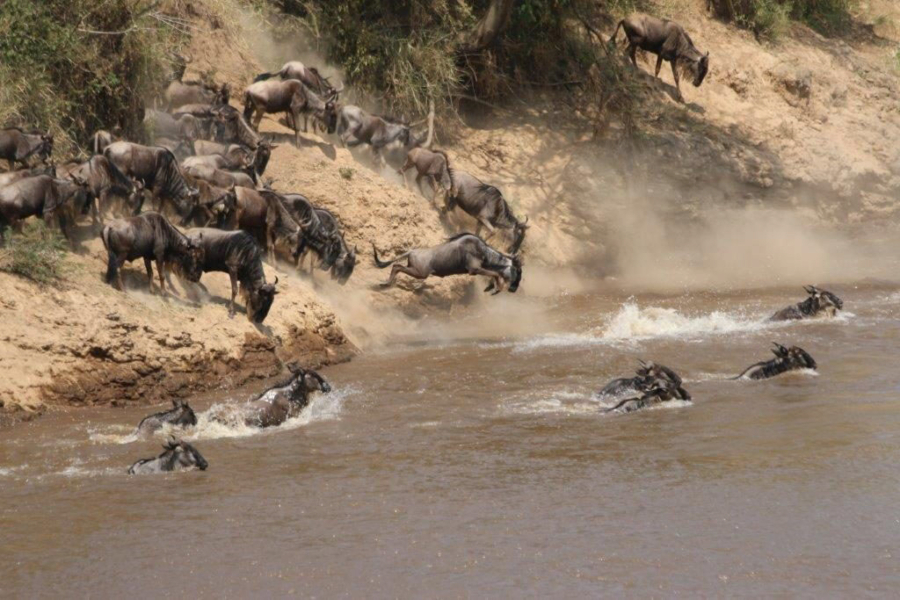African wildebeests are like clueless couples that get hacked to pieces in horror movies. Time after time, year aft er year, giant herds of the animals creep to the edge of the Mara River in Kenya and start to drink, seemingly oblivious to danger.
The spectacle in countless nature documentaries can bring viewers to the edge of their seats. They want to warn them. There are huge crocodiles in the river! Don’t they see the danger? But by this point, the herd is already leaping into the water, the crocs have grabbed a few by their throats and are logrolling to rip away limbs. In no time, the hoofs of hundreds of dead wildebeests are pointing skyward.
It looks awful, but according to a surprising new report led by researchers at Yale University, the yearly massacre of 6,000 wildebeest on the Serengeti is good for the Mara River watershed.
The creatures’ carcasses feed more than a bunch of fat crocodiles. They nourish an entire ecosystem — river fish, plants, microorganisms, hyenas, birds and even hippopotamuses. That’s right, said Amanda Subalusky, a postdoctoral scientist at Yale who now works at the Cary Institute for Ecosystem Studies in New York: Team members observed hippos snacking on the dead bodies of wildebeests.
“It’s like you’re dropping a lot of steaks in the water,” said Subalusky, who lived in Kenya for monthly stretches between 2008 and 2010 to observe the wildebeests and the river for the study. “The river comes alive. Fish start leaping. Predators start moving toward the bank.”
The study, published earlier his month in the journal Proceedings of the National Academy of Sciences, could change how the sciences view the contributions of big herds, alive and dead, to their landscapes.
“It’s … one of the ways a large migration can influence an ecosystem that hasn’t been thought about,” Subalusky said. “It raises the possibility that mass drowning was a more common feature of our landscape. Just the realization that a wildebeest herd can influence an aquatic ecosystem, and the way it does so, is not at first blush obvious.”
Bleeding-heart sympathizers have proposed to help migrating wildebeests, perhaps by building a bridge.
That’s a terrible idea, Subalusky said. Right now, “hundreds of birds and crocodiles and fish and hyenas and mongoose are benefiting.”
When the spectacle of death ends with carcasses littering the river, the flesh falls away into the muddy water, where everything from vultures to tiny organisms feed.
Beneath the water’s surface, bones from thousands of bodies take up to seven years to break down.
“Their persistent influence on the river system is like slow-release fertilizer capsules” feeding plants, she said.
Scientists who study ecosystems try to see the big picture as opposed to a flash of drama. Subalusky and her team — study co-authors Christopher Dutton, Emma Rosi and David Post — aimed to understand how animals move resources. Wildebeests not only nourish the river by dying there en mass, they also nourish the land in spots where they poop and where they decompose after being eaten by lions or other predators.
The Mara River, which runs through one of Earth’s most beautiful wild lands, is itself nothing special.
“I remember, actually, the first time I crossed the Mara, sitting on a bench thinking, ‘Wow, I came halfway around the world to study you,’ ” Subalusky said. “It was small, about 40 meters wide, brown and muddy, filled with sediment.”
But its role in the wildebeest migration fascinated her. The animals see storms on the horizon and move toward them, knowing that the grass they eat grows after the rain.
“They’re driven by such a strong instinct to follow those rains that they cross the river. It’s a tragic thing to observe, actually,” she said.
Tragic and mesmerizing. Millions of wildebeests live on the Serengeti, but they don’t all go to the river at once. They go in clans of tens of thousands. They don’t appear to be aware of the fate that awaits them. Subalusky said they sometimes crossed the river in the morning and traveled back in the afternoon, happily greeted by crocodiles.
“It reeks, and it smells really terrible when it happens,” she said. Still, “it is very moving to watch. You really never see that — hundreds of huge animals drowning.”
At times, the research team understood their subject a little too well. To determine the biological effect wildebeests had on the river, they had to sample water, shock and catch fish, put the bodies in bags and leave them in the water to determine how quickly they decomposed. “I have definitely felt like a nervous wildebeest at the bank of the river,” Subalusky said, knowing crocodiles could lurk anywhere.
“I thought, ‘This is what they feel like,’ ” she said. The team would return for the bags of decomposing fish only to find that a crocodile or other animal had snatched most of them away. They had a welder build a cage to protect the catch.
“A lot of our research involved getting in the river. We have been incredibly fortunate,” she said. “We didn’t have any bad experiences. We had a few close experiences.”



